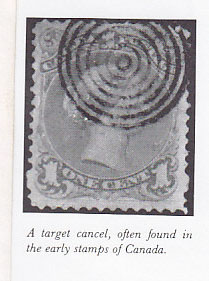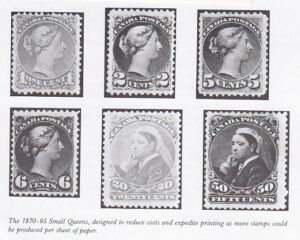The Small Queen issue commenced in 1870, though most values of the Large Queens remained in general use and were slowly replaced by Small Queen issues in the ensuing twenty years. The primary reason for the change was that the demand for stamps in Canada proved to be very great. The smaller format allowed the printers to produce more stamps on the same press in the same amount of time, with the same amount of paper and ink. The Small Queens duplicated the values of the Large Queens, with the addition in 1893 of a 6-cent value and a 20-cent and a 50-cent in a slightly different format. The Small Queens are highly specialized in by some philatelists. For the most part they are relatively inexpensive, and are even cheap in used condition. Shade varieties and perforation varieties abound. There are many reentries and double transfers that collectors like to look for. Double transfers, as noted earlier, are slight doublings of certain portions of the design caused when the plate is originally made and the die is imperfectly rocked in. Reentries look exactly like double transfers. Again, they are ad oubling of a portion of the design, this time cause when the plate is reentered so as to strengthen the design on a worn plate. For those with a good pair of eyes, each reentry and double transfer can be identified according to lists of characteristics discovered by philatelists of the past.

In 1897, the Canadian Post Office signed a stamp printing contract with the American Bank Note Company, though the stipulation was that the printing had to be done in Canada. The 1897 Jubilee issue had as its justification the sixtieth anniversary of the reign of Queen Victoria. Some have suggested, however, that it was patterned after the 1893 Columbus Exposition issue, which had proved so lucrative to the United States Post Office. The values, with the Canadian addition of a one-half-cent stamp, are virtually the same, and the similarity in style is no doubt due to the printing being done by the American Bank Note Company. Virtually the same number of high-value Canadian Jubilees were ordered as were ordered of the dollar-value Columbians. But they didn’t sell as well, and of the three-dollar and four-dollar stamps, less than 10,000 were reported sold. The low values of the set soon sold out to postal users, though deliveries of high values continued to be made until 1901.

